Intel NUC6CAYH (Arches Canyon) Apollo Lake UCFF PC Review
by Ganesh T S on January 12, 2018 8:00 AM EST- Posted in
- Systems
- Intel
- NUC
- UCFF
- Apollo Lake
- Arches Canyon
Performance Metrics - II
In this section, we mainly look at benchmark modes in programs used on a day-to-day basis, i.e, application performance and not synthetic workloads.
x264 Benchmark
First off, we have some video encoding benchmarks courtesy of x264 HD Benchmark v5.0. This is simply a test of CPU performance. As expected, the Celeron J3455 is at the top in both passes. Recent releases of the x264 benchmark can show even more impressive gains, as they make use of the latest and greatest features of the modern Intel processors.


7-Zip
7-Zip is a very effective and efficient compression program, often beating out OpenCL accelerated commercial programs in benchmarks even while using just the CPU power. 7-Zip has a benchmarking program that provides tons of details regarding the underlying CPU's efficiency. In this subsection, we are interested in the compression and decompression MIPS ratings when utilizing all the available threads.


TrueCrypt
As businesses (and even home consumers) become more security conscious, the importance of encryption can't be overstated. CPUs supporting the AES-NI instruction for accelerating the encryption and decryption processes have become more widespread over the last few years. TrueCrypt, a popular open-source disk encryption program can take advantage of the AES-NI capabilities. The TrueCrypt internal benchmark provides some interesting cryptography-related numbers to ponder. In the graph below, we can get an idea of how fast a TrueCrypt volume would behave in the Intel NUC6CAYH and how it would compare with other select PCs. This is a purely CPU feature / clock speed based test.

Agisoft Photoscan
Agisoft PhotoScan is a commercial program that converts 2D images into 3D point maps, meshes and textures. The program designers sent us a command line version in order to evaluate the efficiency of various systems that go under our review scanner. The command line version has two benchmark modes, one using the CPU and the other using both the CPU and GPU (via OpenCL). We have been using an old version of the program with 50 photogaphs in our reviews till now. The updated benchmark (v1.3) now takes around 84 photographs and does four stages of computation:
- Stage 1: Align Photographs (capable of OpenCL acceleration)
- Stage 2: Build Point Cloud (capable of OpenCL acceleration)
- Stage 3: Build Mesh
- Stage 4: Build Textures
We record the time taken for each stage. Since various elements of the software are single threaded, others multithreaded, and some use GPUs, it is interesting to record the effects of CPU generations, speeds, number of cores, DRAM parameters and the GPU using this software.
The GPU turns out to be too weak and is actually detrimental to the performance numbers from the first stage. The second stage's improvement with the GPU enabled is within the margin of error that one encounters from run to run.
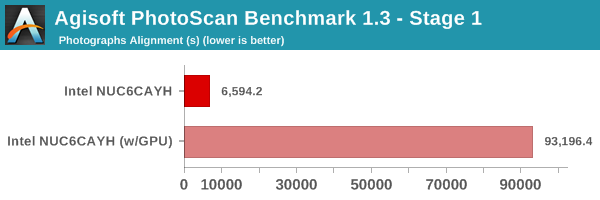
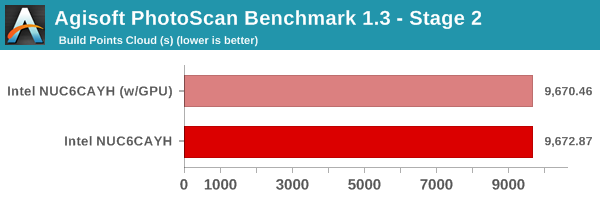
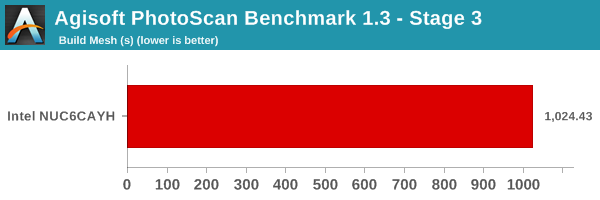
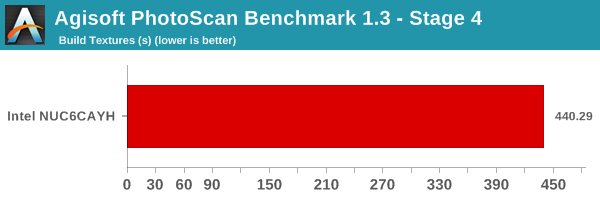
Dolphin Emulator
Wrapping up our application benchmark numbers is the new Dolphin Emulator (v5) benchmark mode results. This is again a test of the CPU capabilities, but, we do not have numbers with other systems to compare against.
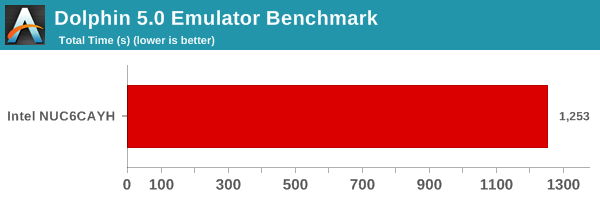










54 Comments
View All Comments
Badelhas - Monday, January 15, 2018 - link
Such a coincidence, I bought the NUC6CAYS two days ago, to use it has a HTPC, but I´ve been having multiple issues. One of the reasons I bought this was because it has a SPDIF Toslink Optical port, so I though I could connect it to my Home Cinema and have 5.1 digital sound but that dosent happen, I can only get PCM (stereo) sound. I have all Intel drivers installed, does anybody have a clue why this is happening?I also been having much trouble updating Windows 10 to the Fall Creators Update since it says I dont have enough space, which is incredible.
Cheers
Macpoedel - Monday, January 15, 2018 - link
Are you using software that supports audio passthrough, and are you playing videos that have Dolby Digital 5.1 or DTS encoded audio tracks (probably otherwise you wouldn't be asking)?I have a NUC6CAYH and have no problems passing through DTS(-HD) from Kodi 17, but I do so over HDMI.
Badelhas - Thursday, January 18, 2018 - link
I am playing movies with 5.1 and it doesn't work. But the problem comes before even playing the movie. The moment I connect my Sony Home Cinema to my main PC though the Optical out port on the Asus DX Sound-card the home cinema changes from "PCM" to "DIGITAL", showing me that it is working. When I do this with the Intel NUC it doesn't, even selecting Digial Out on the Windows or Realtek Sound settings. Very disappointing, to be honest, and Intel Community administrators have been of no help on their forums...mode_13h - Monday, January 15, 2018 - link
"The Celeron J3455 is a quad-core processor with a 10W TDP. It easily enabled the NUC6CAH to come out on top in all of our benchmarks when compared against other Atom-class systems."Actually, I imagine the combination of dual-channel memory and a desktop-class SSD might've been bigger factors.
mode_13h - Monday, January 15, 2018 - link
BTW, thanks for this review. I'm very interested in such low-power systems.However, I was quite disappointed to see no i3 desktop-class system used in any of the comparisons besides the first. It's relevant and important to know how much performance one is sacrificing, when going with a low power "Atom-class" CPU. It would've been appreciated and appropriate at least to include the next higher model of NUC.
I hope that you address this if/when you review a Gemini Lake NUC.
Badelhas - Thursday, January 18, 2018 - link
This is not an Atom but a Celerom, much better.mode_13h - Thursday, January 18, 2018 - link
At the end of the day, those are just brand names. Both are still in use, actually, but I was referring to its lineage.IMO, highlighting it as a "Celeron" muddies the waters, since Intel has shipped Celerons with mainstream (e.g. Skylake) cores, yet this uses the low-power Goldmont core.
nevcairiel - Tuesday, January 16, 2018 - link
I would've liked performance comparisons to the previous generation NUC in the same price class, ie. the one this one replaces. Seeing the clear generational gain would've been sweet.Macpoedel - Wednesday, January 17, 2018 - link
The previous generation low-end NUCs had mobile Braswell CPU's (NUC5CPYH had a Celeron N3050 and NUC5PPYH had a Pentium N3700). It's not exactly the same, but the AsRock Beebox N3000 is a pretty good approximate for the N3050 NUC, it's also a dual core and the burst clock speed isn't that much lower.The NUC6CAYH is more of a successor to the NUC5CPYH in pricing, but the Celeron J3455 in this NUC performs more like the Pentium based predecessor, so the gains are pretty big. You can see that it's twice as fast in a lot of benchmarks, mostly because the amount of cores doubled. Power consumption has gone up as well, but that's also because the newer NUC's CPU has a greater power envelop, so it'll spend more time at boost speeds.
But, having a NUC6CAYH myself, I was a bit disappointed with the performance. It's totally adequate for use as a HTPC or as a low power desktop (if you only edit documents or surf some webpages, but don't multitask too much), but the Core based NUCs are a lot faster (the i3 version costs twice as much though, I would be interested in a Kaby Lake Celeron based NUC like the original Sandy Bridge NUC).
mikato - Wednesday, January 17, 2018 - link
Now we really need an AMD Zen APU UCFF to compare. Is Zotac making a Zbox with one when they come out maybe?